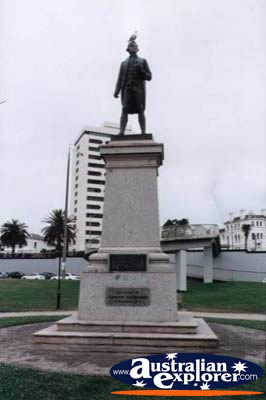Captain Cook is arguably the most famous explorer of Australia. He was born in Marton, England and spent several years working for a shipbuilding firm before enlisting in the navy in 1755.
Between 1756 and 1767 Cook set about charting the North Atlantic coastal waters off Newfoundland and Nova Scotia and the Saint Lawrence River.
His first great voyage, to the South Pacific, began in 1768 whilst in command of the Endeavour. Tahiti was his destination and the purpose, to transport British astronomers to the island in order to observe the movement of the planet Venus across the sun in June 1769.
 Next he proceeded to New Zealand, where he took formal possession of areas from both the main islands and accurately charted 3860 km of coastline for the first time. During 1770 he discovered the east coast of Australia, which he charted and claimed for Great Britain under the name of New South Wales.
Next he proceeded to New Zealand, where he took formal possession of areas from both the main islands and accurately charted 3860 km of coastline for the first time. During 1770 he discovered the east coast of Australia, which he charted and claimed for Great Britain under the name of New South Wales.
Cook was promoted to the rank of commander when he returned to England in 1771. Captain Cook's second great expedition began in 1772 whilst in command of the Resolution. This time he was accompanied by another ship named the Adventure and the task ahead was to search for the legendary southern continent, named Terra Australis. At this time Africa was believed to be part of this continent.
After sailing along the Antarctic ice block in the South Pacific, Cook crossed the Antarctic Circle on January 16th 1773. It is here that he found the Islands that were later named after him. He discovered New Caledonia and Niue along with other Pacific Islands in 1774 as he charted the New Hebrides, the Marquesas, and the Easter Island. Cook returned to England in 1775, where he was made a member of the Royal Society and was also awarded the Copley medal for his scientific achievement.
Cook always insisted that hygiene and diet were kept to the optimum, which resulted in minimal numbers of scurvy cases amongst the crew during the journey. The three-year exploration was recognised for this, plus the fact that he had proven that no Southern continent existed. All that was present was the Antarctic region.
Captain James Cook's final journey was to North America in 1776, in search of a Northwest Passage between the Atlantic and Pacific Oceans. During his travels he visited the Mid-Pacific and discovered and charted the Hawaiian Islands in 1778. Cook originally named the Hawaiian Islands the "Sandwich Islands" after his friend and supporter John Montague, the Fourth Earl of Sandwich.
Cook's search for a Northwest Passage was unsuccessful and he was forced to go back due to ice in the Bering Strait. Cook finally moored in Kealakekua Bay on the Big Island of Hawaii's Kona Coast. Cook was initially welcomed and one month later he left Hawaii. However, the ship was forced to return one week later due to a damaged foremast. After returning, one of Cook's guards was killed and one of the ship's longboats was stolen. This resulted in a battle with some of the islanders. Cook met his death in the Hawaiian Islands during the battle.


